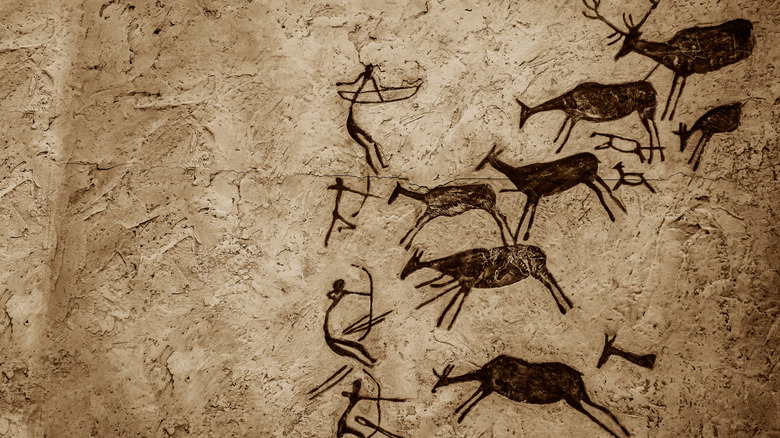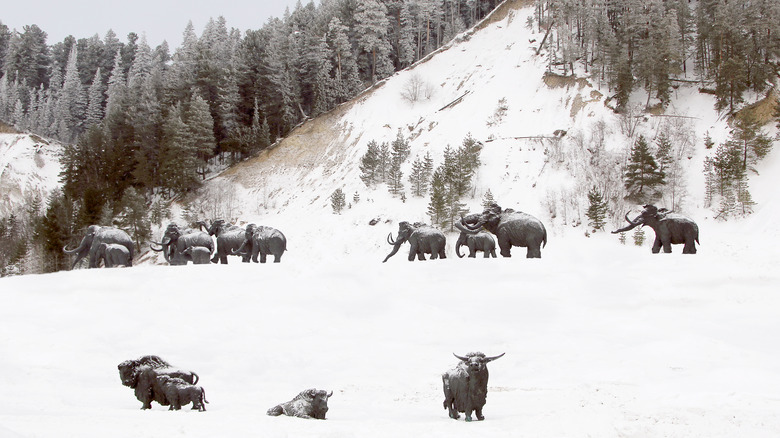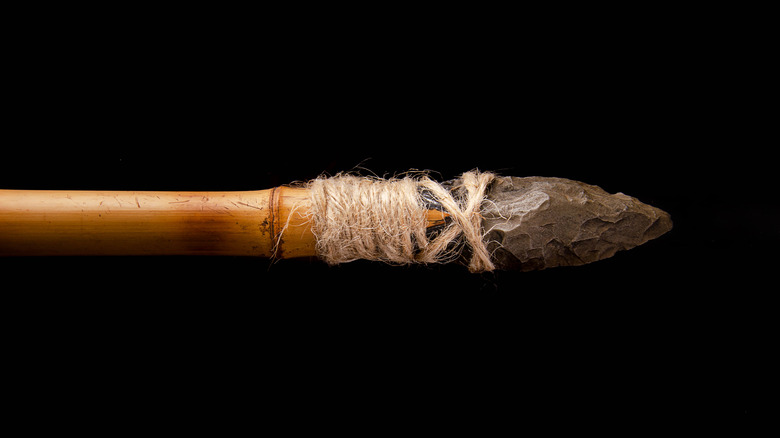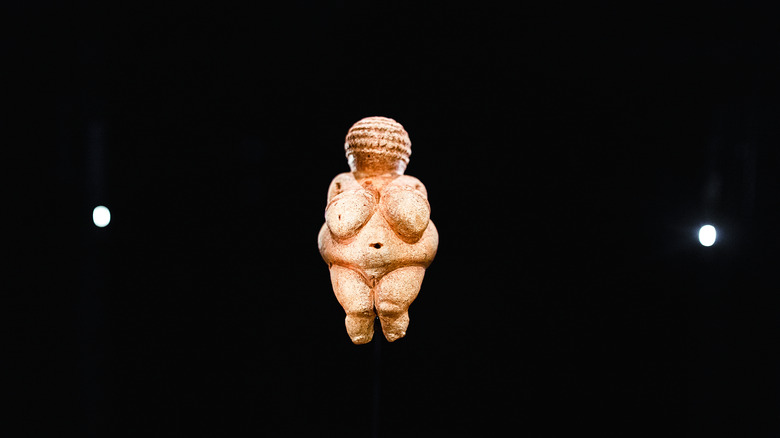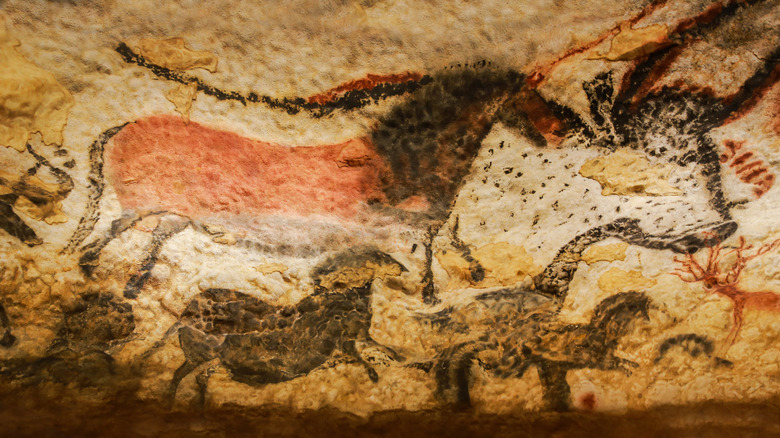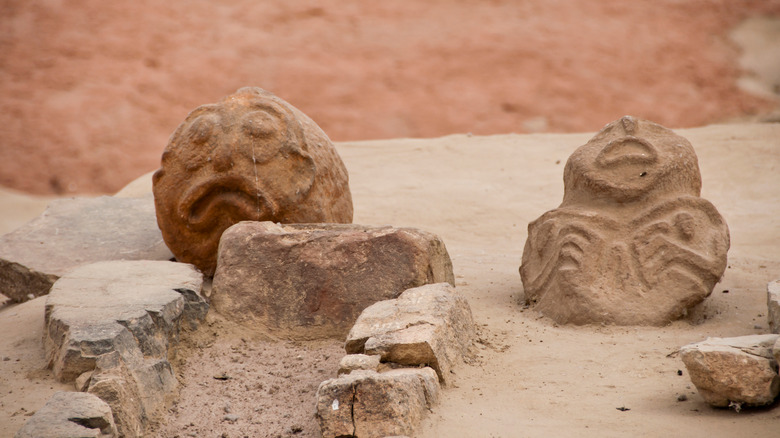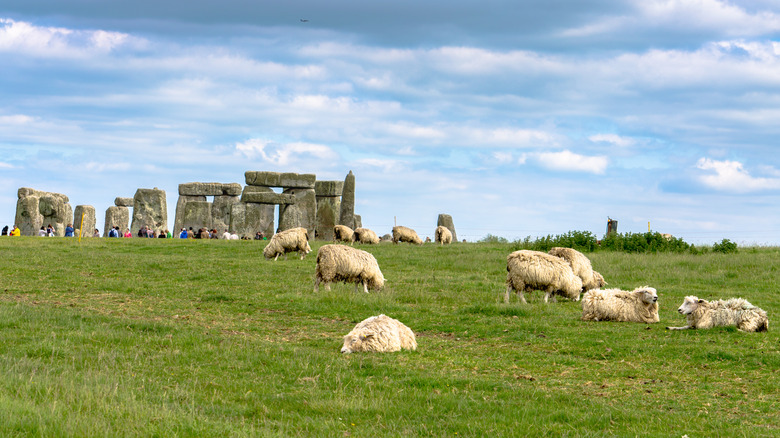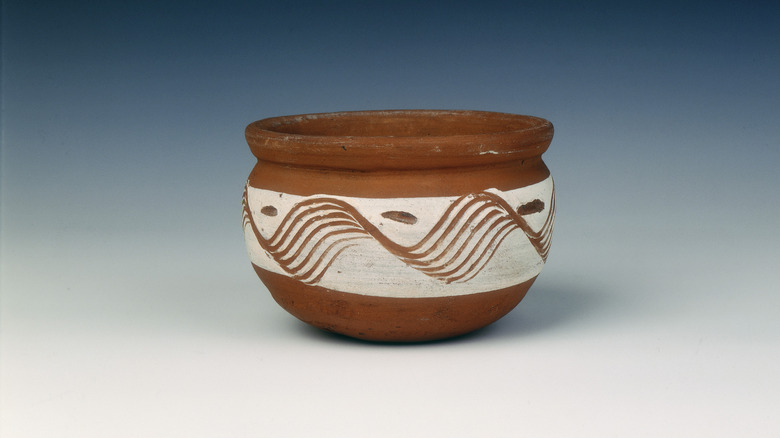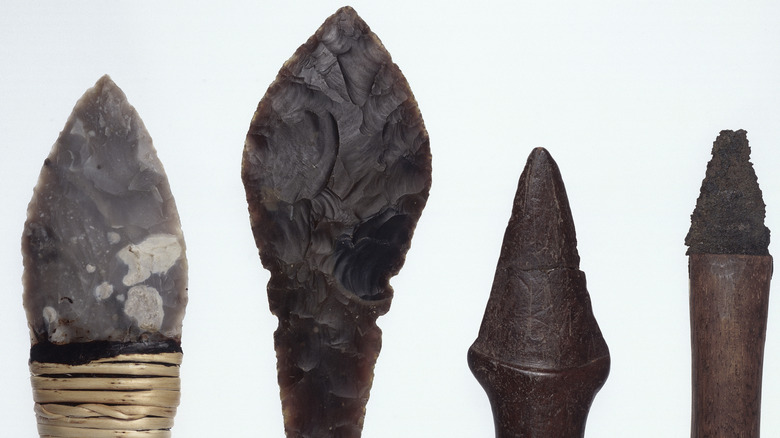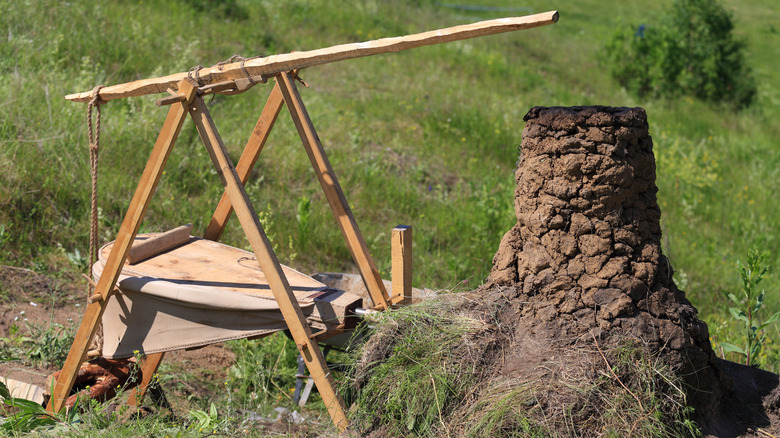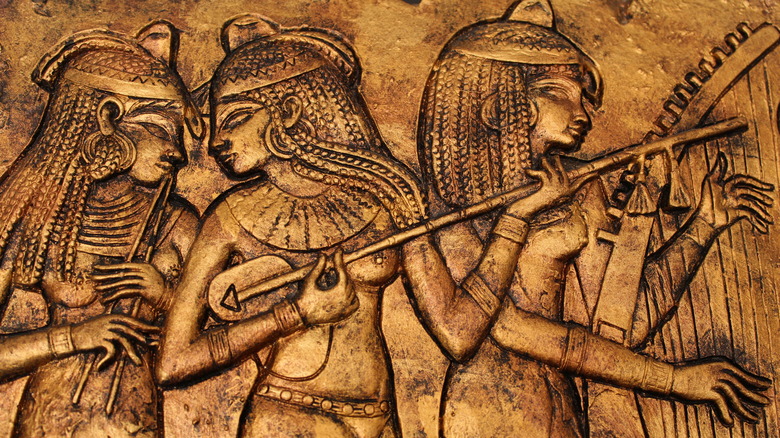The Stone Age Timeline Explained
It's no easy task to figure out the specifics of an era before written records. As per History, the Stone Age marked the beginning (and made up the biggest chunk) of the Prehistoric Era — or the era before humans left written accounts about their lives, otherwise known as history. However, the Stone Age spanned over 2 million years, and this gave humans plenty of time to leave behind artifacts (via World History Encyclopedia). These include tools (which give an insight into humans' hunter-gatherer lifestyle as well as the transition toward agriculture), art (proving creativity, as well as ritualistic thinking, are old affairs), and architecture.
The Stone Age is split into three periods: the Paleolithic (or Old Stone Age), Mesolithic (Middle Stone Age), and Neolithic (New Stone Age). As humans evolved, so did their tools, habits, and lifestyle — the three periods are meant to show these changes and mark the milestones of human evolution. So let's dive into the Stone Age timeline and trace the steps of our species' complex journey.
The Pleistocene Era (2.6 million years ago – 12,000 B.C.)
In short, the Pleistocene Era is the Paleolithic Era understood from Earth's perspective. As per World History Encyclopedia, both periods spanned from 2.6 million years B.C. — 12,000 B.C. PBS Eons breaks down what makes the Pleistocene special — it's what we know as the Ice Age epoch, except it's more accurate to talk about the "Ice Ages." The Pleistocene was defined by constant rises and falls in Earth's temperatures, thus causing several Ice Ages as well as warm periods with ice melting and forming large bodies of water.
Needless to say, the constant changes affected the planet and its species, many of which were giant mammals: mammoths, mastodons, giant sloths, saber-tooth tigers, and wooly rhinos (via Live Science). The wooly rhino, for example, was restricted in the Central Asian and Siberian regions during warm periods but expanded its territory to all of Asia and even Europe during the Ice Ages.
The climate cycles never really came to an end — thanks to Earth constantly changing its position, tilt, and distance from the Sun, our planet keeps warming up and cooling down. But we might never get an Ice Age like the Last Glacial Maximum, 20,000 years ago. Since then, the planet kept warming up, with the cooldown periods reaching higher lows. After the final Ice Age, the vast tundras turned to rivers and grasslands, the giant mammals went extinct, and humans gained control of their environment, marking the beginning of the Holocene.
The Paleolithic Era (2.6 million years ago - 12,000 B.C.)
As History reports, the Paleolithic Era — or the Old Stone Age — is defined by humans using basic tools made of stone and bone, and living as hunters and gatherers. But the Paleolithic Era itself is divided into three periods, as per Historic England: the Lower (before 300,000 years ago), Middle (300,000 — 40,000 B.C.), and Upper Paleolithic (40,000 — 11,000 B.C.). The Lower Paleolithic ended with a spike in global temperatures and, most notably, with the evolution of Homo Sapiens, the species we belong to today (via Smithsonian).
During the Paleolithic Era, humans used fire to cook their prey, which included very large animals like woolly mammoths, but also birds and fish. As hunter-gatherers, humans still lived in caves or rudimentary tepees. But as the Paleolithic is the longest Stone Age period, it's easy to see a clear evolution in humans' tools and weapons, as World History Encyclopedia suggests. The Oldowan stone technology (flakes and choppers) evolved into the Acheulean (symmetrical shapes and sharper edges), some 1.7 million years ago. From then, tools got increasingly complex and effective in hunting. With the weapon "revolution" in the Upper Paleolithic came cave art, stone figurines, and rudimentary jewelry.
The Paleolithic Era: Venus figurines (23,000 B.C.)
Body standards and beauty ideals have changed many times throughout history. The Paleolithic "Venus" figurines might just be our earliest example of this. As per World History Encyclopedia, there are over 200 such figurines, found in Europe and Asia, dating back to around 23,000 B.C. Indeed, the name "Venus figurines" has been coined by historians and is not entirely accurate, as the myth of the goddess Venus came much later than the actual statuettes. But just like in the case of Venus, these ancient figurines are associated with fertility and perhaps even attractiveness.
According to this 2011 study, the "Venus" figurines are symbols of hope for survival during the unforgiving Ice Age. As there were probably few to no obese women during the cold, harsh period, the statuettes stand as a survival (and fertility) ideal more than a beauty one. A bigger, stronger body is able to produce more offspring and survive freezing temperatures better, so it's safe to say that, 25,000 years ago, beauty was equivalent to good health.
The Paleolithic Era: Lascaux Cave Paintings (17,000 – 15,000 B.C.)
On September 12, 1940, four boys followed their dog down a widened foxhole down into the Lascaux Caves, in southwestern France (via World History Encyclopedia). That day, they discovered an unprecedented quantity of ancient art — almost 600 paintings of animals (and a few humans), and 1,400 engravings. All art was dated to 17,000 — 15,000 B.C., during the Upper Paleolithic. Upon inspecting the Lascaux Cave, archaeologists determined that its residents also used lamps fuelled by animal fat and sat around fireplaces inside the cave. They painted its walls with red (made from hematite, raw or found in red clay), yellow (from iron oxyhydroxides), and black paint (charcoal or manganese oxides).
The "what" and "how"s are all too clear, but what about the "why"? As per Google Arts and Culture, the reason behind the Lascaux paintings (and other Paleolithic cave paintings) is still being debated, but there are a few theories. On the one hand, people might have already had an aesthetic sense, decorating their walls just like we decorate our homes today. On the other hand, the animals painted (most of them bison, horses, and deer) might have been worshipped or seen as guardians, spirit animals, or totems of certain human clans.
But since many depictions of the animals also show arrows and even hunters, the most likely theory is that humans believed the painting would bring them luck while hunting. This shows the beginning of spiritual thinking in humans.
The Mesolithic Era (12,000 – c. 9,000 B.C.)
Although much shorter than the Old Stone Age, the Mesolithic — or Middle Stone Age — has less clear timeline margins. As per World History Encyclopedia, it's the period between the end of the last Ice Age and the beginning of the Agricultural Revolution. But since these happened at different times around the globe (Southeast Europe developed agriculture around 7,000 B.C., but Northern Europe only did so 3,000 years later), a clear timestamp can't be put on the end of the era.
As History reports, rising temperatures following the end of the great last Ice Age caused humans to migrate. For most of the Mesolithic period, they lived as nomads, often settling for short periods of time next to bodies of water. As Dr. James Dilley explains, Prehistoric humans followed the animals they relied on for food. And as the climate changes caused animal species to move (or change entirely), humans moved as well.
During the Mesolithic, humans' weapons evolved to sharp flint blades, antler-made axes, and small tools that were used to fix or upgrade weapons and clothing. And of course, it was during the end of the Mesolithic that humans discovered how to cultivate cereal, which marked the beginning of settled human civilization as we know it.
The Mesolithic Era: the beginnings of agriculture (9,000 B.C.)
Huge developments rarely happen overnight. So, although the Agricultural Revolution belongs to the Neolithic Era, it was during the end of the Mesolithic that humans laid its ground. As World History Encyclopedia confirms, this happened in the Fertile Crescent, where everything pertaining to the development of human civilization happened. From 10,000 to 9,000 B.C., the Fertile Crescent — the area from the Persian Gulf to modern-day southern Iraq, Syria, Lebanon, Jordan, Israel, and northern Egypt — saw agriculture develop simultaneously with animal domestication.
Cereals and wild grains were the first to be cultivated by the Mesopotamian civilizations, becoming common practice by 9,000 B.C. Within 4,000 years, humans in the area had also developed irrigation systems. Around the same time, wild sheep were also being raised for their wool. This is how humans changed their nomadic, hunter-gatherer lifestyle to a sedentary one, cultivating the land around them (via History). Settlements turned into rural communities, which in turn grew into the world's very first cities: Eridu (founded in 5,400 B.C.) and Uruk.
The Neolithic Era (8,000 – 3,000 B.C.)
The Neolithic Era marked the start of the Agricultural Revolution, which in turn marked the beginning of civilization as we know it. As professor S. James Gates, Jr., comments to History: "When we discovered how to farm, we suddenly increased the ability of the land to support us." John Green explains how this helped humanity on Crash Course: Hunter-gatherers would burn the same amount of calories that they would get by hunting or foraging for nuts and berries. Once people started cultivating cereal and domesticating animals, they started getting a food surplus: enough to store or give to others.
This led to specialization of labor: some people could grow food while others could specialize in making better equipment, clothes, and architecture. Agriculture thus had a snowball effect on human civilization: Food abundance led to more time to develop other technologies, which in turn led to better ways of growing and storing food. Soon enough, the Neolithic Era saw the development of cities, trade, jobs, and travel (via History). This was also the time when humans started severely altering their environment, manipulating it to their benefit — the Neolithic Era laid the ground for everything we do today, from using cutting-edge technology to deforestation and overfishing.
The Neolithic Era: pottery (8,000 B.C.)
One of the greatest human inventions during the Neolithic era was the oven — as World History Encyclopedia reports, this happened around 10,000 years ago. With ovens came the development of pottery, which humans used to store as well as cook their food. Interestingly, archaeologists noticed tooth wear around the time humans switched from a meat-based diet to eating ground cereal. But after the introduction of pottery, tooth wear was replaced by bad teeth — humans had started to eat porridge and gruel, made in their new pots.
As per Crafts Hero, pots became increasingly decorated throughout the Neolithic Era. Pottery technology also evolved, from earthenware (heated at 1,000 — 1,200 degrees Celsius) to stoneware (1,100 — 1,300 degrees Celcius) to porcelain, which was perfected by the Chinese civilization. As Sotheby's and the Met Museum show, Neolithic pottery in China was exceptionally complex, with diverse shapes and functions appearing on the Yellow and Yangzi river systems. Whether bearing animal shapes or simply decorated with geometrical shapes, Neolithic pots appeared around the globe, serving as water holders, cookers, or vessels of ritualistic practice.
The Neolithic Era: domestication (7,000 – 6,000 B.C.)
One huge part of the Neolithic Agricultural Revolution was the domestication of wild animals: as per Crash Course, these included sheep, cattle, pigs, goats, horses, and camels. Apparently, some 13,000 years ago, humans in modern-day Greece domesticated snails, too (however, this didn't lead to an agricultural revolution). Animal domestication as we know it happened between 7,000 and 6,000 B.C., and as History explains, it happened simultaneously in different, unconnected parts of the world (moving from plant to animal domestication every time). This goes to show just how important domestication was for human evolution.
As National Geographic reports, Neolithic humans chose the animals best suited to give them meat, milk, fur, and skin, or help them with transportation. Then, the animals were bred selectively so that their offspring would have the traits desired by the farmers. 10,000 years and a few technological milestones later, we have species that are entirely different from their Prehistoric ancestors, all thanks to humans' necessity for more food.
The Neolithic Era: trade (7,500 B.C.)
Back in pre-Neolithic times, humans mostly fended for themselves or their children, as they had little time or energy to do otherwise. But thanks to the Agricultural Revolution, people started producing more than enough food, thus generating a more complex trading process. As per World History Encyclopedia, the first obsidian long-distance trade route is dated back to 7,500 B.C. A 2017 study confirms the trade routes and suggests that the obsidian pieces would travel up to 160 kilometers throughout Eastern Africa.
But Neolithic humans would trade much more than obsidian. As History reports, trade routes were developed hand-in-hand with animal domestication — especially large animals like oxen, horses, donkeys, and camels, that could carry humans' goods down the established routes. Of course, trade routes had their disadvantages, too. Now, different villages and even civilizations could come face-to-face. While they could share goods and knowledge, they would also fight over resources and territory.
The Neolithic Era: copper (6,200 B.C.)
By 6000 B.C., humans were slowly paving the way to the Bronze Age. As per World History Encyclopedia, copper was first discovered (and smelted into various tools) in Anatolia, modern-day Turkey, in 6200 B.C. But as Britannica suggests, copper was used only for tiny, precious objects during that time, and it took a few thousand years until it was paired up with tin to create the powerful bronze.
A 2000 Paléorient study traces the first examples of copper smelting to the Eastern Mediterranean and explains that charcoal played a crucial role in the development of metallurgy. As furnaces for melting copper and iron appeared throughout the globe, what is known as the Copper Era, the Copper-Stone Age, or the Chalcolithic began. This is the transition period between the Stone Age and the Bronze Age, as per a 2019 Journal of World Prehistory study.
Neolithic civilizations used copper to craft weapons, dishes, jewelry, figurines, and decorative friezes for their temples (via World History Encyclopedia). Overall, copper is much softer and less resistant than bronze. The growing need for stronger weapons (due to the increase in wars) led to the development of bronze metallurgy, which marked the beginning of a new age.
The Neolithic Era: the wheel (3,500 B.C.)
The wheel might seem like a basic, common-sense object to have, but as Smithsonian Magazine reports, there are no wheels in nature (dung beetles and tumbleweeds might offer a lesson on spheres, but they aren't obvious examples). So it wasn't an easy task for the human being to conceive it. In fact, humans invented the flute before they thought to make the wheel. Around 3500 B.C., Neolithic people in the Mesopotamian region created wheels to serve potters in their work. Indeed, the first function of the wheel was not transportation, but potter's wheels — it took three more centuries for people to put wheels on chariots.
Soon enough, various wheeled vehicles started spreading throughout the Middle East and Eastern Europe, as ThoughtCo reports. Sometime after, the Ancient Greeks also developed the wheelbarrow. Another huge development happened around 3370 B.C. when the wheels were paired with axles (The Bronocice pot standing as proof of this). Thanks to axles, carts were more stable and turned corners without risk of toppling over. This was the start of transportation: Humans could move cargo and travel between settlements much more easily, opening the door to a world of discovery and ever more evolution.
The Neolithic Era: social hierarchies (3,000 B.C.)
Here's where our history takes an interesting, albeit sad, twist. As World History Encyclopedia reports, during the Neolithic, humans became sedentary and expanded their territories from settlements to cities. Around this time, arrowheads were perfected while hunting was almost forgotten. Why? The answer lies in the many human skeletons discovered with arrowheads still stuck in their bones. The conclusion? Larger settlements lead to bigger conflicts.
There's more: as per Wired, socio-economic inequalities existed pretty much as early as human civilization, which dates back to the Neolithic. Archaeologists have uncovered Mesopotamian civilizations from 9000 B.C. with substantial differences between tooth quality and burial sites. This goes to show that, as soon as the Agricultural Revolution allowed people to specialize in different jobs, there were jobs that were considered more important than others. Crash Course paints a grimmer picture: "Farming is hard. So hard [that] one is tempted to claim ownership over other humans and then have them till the land on your behalf, which is the kind of non-ideal social order [associated] with agricultural communities."
As World History shows, Ancient Egypt had an extremely rigid social hierarchy, with kings at the top of the pyramid and slaves at the bottom (and several categories in between). It's perhaps difficult to acknowledge how this degree of inequality and injustice was the inevitable companion of human evolution and civilization development. But as history teaches us, we can't have one without the other.
